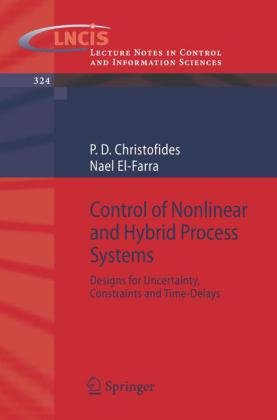P.D. Christofides; Nael El-Farra3540284567, 9783540284567
Table of contents :
front-matter.pdf……Page 1
1.1 Motivation……Page 12
1.2 Background on Analysis and Controlof Nonlinear Systems……Page 13
1.3.1 Non-Isothermal Continuous Stirred Tank Reactors……Page 15
1.4 Background on Analysis and Controlof Hybrid Systems……Page 17
1.5.1 Fault-Tolerant Process Control Systems……Page 19
1.5.2 Switched Biological Systems……Page 21
1.6 Objectives and Organization of the Book……Page 22
2.1 Stability of Nonlinear Systems……Page 26
2.1.1 Stability Definitions……Page 27
2.1.2 Stability Characterizations Using Function Classes K, K, and KL……Page 28
2.1.3 Lyapunov’s Direct (Second) Method……Page 29
2.1.4 LaSalle’s Invariance Principle……Page 30
2.1.5 Lyapunov’s Indirect (First) Method……Page 31
2.1.6 Input-to-State Stability……Page 32
2.2 Stabilization of Nonlinear Systems……Page 33
2.3 Feedback Linearization and Zero Dynamics……Page 35
2.4 Singularly Perturbed Systems……Page 38
3.1 Introduction……Page 43
3.2 Preliminaries……Page 44
3.3.1 Control Problem Formulation……Page 46
3.3.2 Controller Design Under Vanishing Uncertainties……Page 47
3.3.3 Controller Design Under Non-Vanishing Uncertainties……Page 54
3.3.4 Illustrative Example……Page 57
3.4 Robust Near-Optimal Output Feedback Controller Design……Page 60
3.4.1 Control Problem Formulation……Page 61
3.4.2 Near-Optimality Over the Infinite Horizon……Page 64
3.4.3 Near-Optimality Over the Finite Horizon……Page 67
3.4.4 Application to a Non-Isothermal Chemical Reactor……Page 68
3.5 Robust Control of Nonlinear Singulary-Perturbed Systems……Page 79
3.5.2 Robust Output Feedback Controller Synthesis……Page 81
3.6 Conclusions……Page 82
4.1 Introduction……Page 84
4.2 Preliminaries……Page 86
4.3.1 Control Problem Formulation……Page 87
4.3.2 Controller Synthesis……Page 88
4.4 Application to an Exothermic Chemical Reactor……Page 98
4.5.1 Control Problem Formulation……Page 108
4.5.2 Controller Synthesis……Page 109
4.6 Robust Stabilization of a Chemical Reactor Via Output Feedback Control……Page 113
4.7.1 Motivation and Background……Page 119
4.7.2 A PID Controller Tuning Method Using Nonlinear Control Tools……Page 121
4.7.3 Application to a Chemical Reactor Example……Page 128
4.8 Conclusions……Page 135
5.1 Introduction……Page 136
5.2.1 Model Predictive Control……Page 139
5.2.2 Bounded Lyapunov-Based Control……Page 140
5.3.1 Problem Formulation: Uniting MPC and Bounded Control……Page 143
5.3.2 Stability-Based Controller Switching……Page 144
5.3.3 Performance-Driven Switching……Page 148
5.3.4 Switching Using Advanced MPC Formulations……Page 150
5.3.5 Simulation Example……Page 153
5.4 Hybrid Predictive Output Feedback Control……Page 160
5.4.1 Preliminaries……Page 162
5.4.2 Stability Properties Under Output Feedback Control……Page 164
5.4.3 Hybrid Predictive Controller Design……Page 168
5.4.4 Simulation Studies……Page 173
5.5 Conclusions……Page 185
6.1 Introduction……Page 187
6.2.1 Preliminaries……Page 190
6.2.2 Controller Switching Strategies……Page 193
6.2.3 Applications to Chemical Process Examples……Page 202
6.3 Robust Hybrid Predictive Controlof Nonlinear Systems……Page 210
6.3.1 Preliminaries……Page 213
6.3.2 Robust Hybrid Predictive Controller Design……Page 217
6.3.3 Application to Robust Stabilizationof a Chemical Reactor……Page 225
6.4 Conclusions……Page 231
7.1 Introduction……Page 232
7.2.1 State-Space Description……Page 233
7.2.2 Stability Analysis Via Multiple Lyapunov Functions……Page 234
7.2.3 Illustrative Example……Page 235
7.3.1 Problem Formulation and Solution Overview……Page 238
7.3.2 Hybrid Control Strategy Under Vanishing Uncertainty……Page 239
7.3.3 Hybrid Control Strategy Under Non-Vanishing Uncertainty……Page 244
7.3.4 Application to Input/Output Linearizable Processes……Page 246
7.3.5 Application to a Switched Chemical Reactor……Page 248
7.4 Predictive Control of Switched Nonlinear Systems……Page 254
7.4.1 Preliminaries……Page 256
7.4.2 Bounded Lyapunov-Based Controller Design……Page 257
7.4.3 Lyapunov-Based Predictive Controller Design……Page 259
7.4.4 Predictive Control with Scheduled Mode Transitions……Page 261
7.4.5 Application to a Chemical Process Example……Page 267
7.5 Applications of Hybrid Systems Toolsto Biological Networks……Page 270
7.5.1 A Switched System Representation of Biological Networks……Page 272
7.5.2 Methodology for Analysis of Mode Transitions……Page 273
7.5.3 Application to Eukaryotic Cell Cycle Regulation……Page 277
7.6 Conclusions……Page 282
8.1 Introduction……Page 283
8.2.1 System Description……Page 286
8.2.2 Problem Statement and Solution Overview……Page 287
8.2.3 Motivating Example……Page 288
8.3.1 Constrained Feedback Controller Synthesis……Page 291
8.3.2 Characterization of Fault–Recovery Regions……Page 296
8.3.3 Supervisory Switching Logic Design……Page 297
8.3.4 Design of the Communication Logic……Page 298
8.4 Simulation Studies……Page 299
8.4.1 Application to a Single Chemical Reactor……Page 301
8.4.2 Application to Two Chemical Reactors in Series……Page 309
8.5 Conclusions……Page 316
9.1 Introduction……Page 317
9.2.1 Description of Nonlinear DDE Systems……Page 319
9.2.2 Example of a Chemical Process Modeled by a Nonlinear DDE System……Page 321
9.3.1 Spectral Properties……Page 322
9.3.2 Stability Concepts and Results……Page 324
9.4 Nonlinear Control of DDE Systemswith Small Time Delays……Page 326
9.5.1 Problem Statement……Page 327
9.6 Nonlinear State Feedback Control for DDE Systemswith State Delays……Page 328
9.7 Nonlinear State Observer Design for DDE Systemswith State Delay……Page 335
9.8 Nonlinear Output Feedback Control of DDE Systemswith State Delay……Page 339
9.9 Nonlinear Output Feedback Control for DDE Systemswith State and Measurement Delay……Page 341
9.10.1 Process Description — Control Problem Formulation……Page 343
9.10.2 State Feedback Controller Design……Page 345
9.10.3 State Observer and Output Feedback Controller Design……Page 346
9.10.4 Closed-Loop System Simulations……Page 348
9.11.1 Process Modeling — Control Problem Formulation……Page 351
9.11.2 State Feedback Controller Design……Page 356
9.11.4 Closed-Loop System Simulations……Page 358
9.12 Conclusions……Page 361
A Proofs of Chapter 3……Page 363
B Proofs of Chapter 4……Page 391
C Proofs of Chapter 5……Page 401
D Proofs of Chapter 6……Page 409
E Proofs of Chapter 7……Page 413
F Proofs of Chapter 9……Page 425

Reviews
There are no reviews yet.